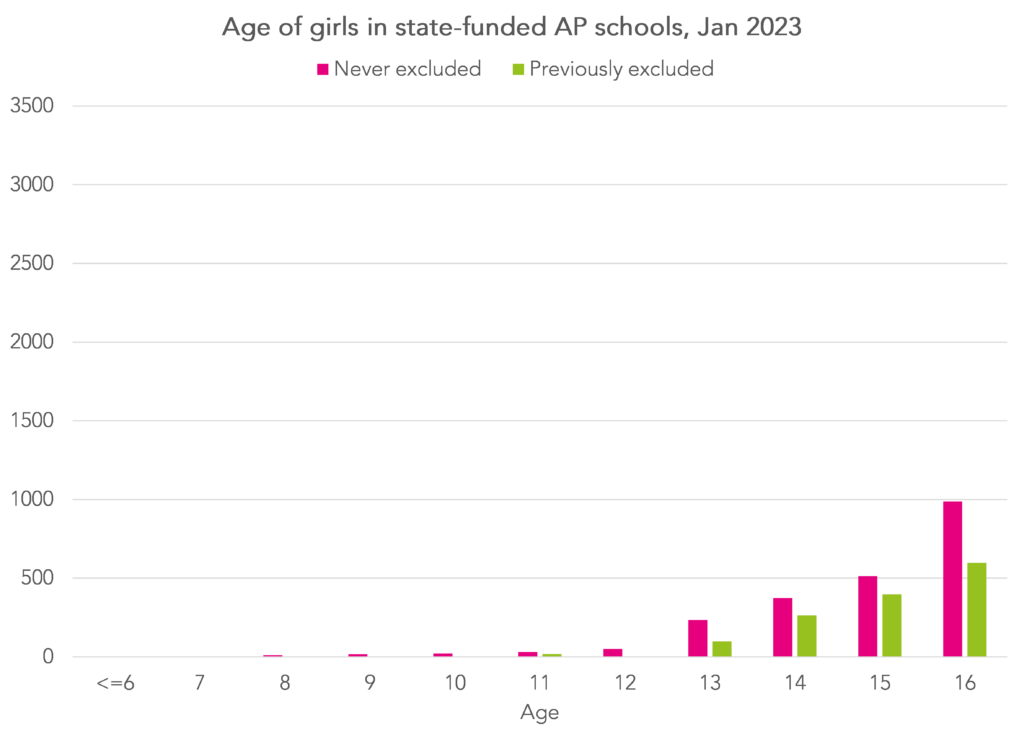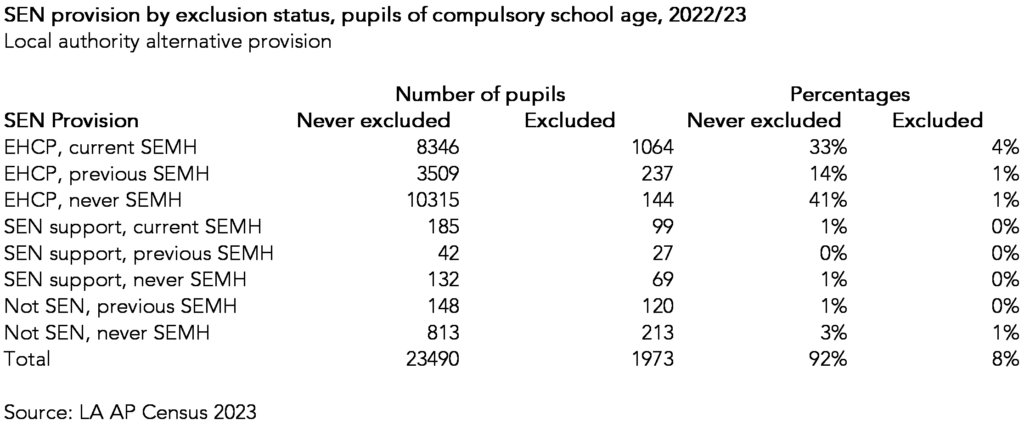State-funded alternative provision (AP) schools are often thought of as schools for excluded pupils. But as we wrote here, not all their pupils have experienced permanent exclusion.
A cursory look at the Department for Education’s website says that AP schools are for pupils who “can’t attend mainstream schools”. Reasons might include illness, behavioural issues or being without a school place for whatever reason.
The Green Paper on Special Educational Needs and Disabilities (SEND) made the distinction between pupils for whom AP placements were time-limited and those for whom it was “transitional”.
Those on time-limited placements would tend to be dual-registered, attending an AP school for a short-time before (all being well) returning full-time to their main school.
Those on “transitional” placements would tend to be either single-registered or mainly registered in the AP sector.
Data
For this blog, we primarily use School Census data from January 2023.
We identify pupils attending AP schools with an enrolment status of C (Current) and M (Main). These are pupils on “transitional” placements.
We construct a range of variables summarizing pupils’ school histories up to January 2023 from earlier termly School Census returns and also exclusions data up to the end of 2022, the most recent available at the time of writing.
The variables we calculate are:
- Ever permanently excluded up to end of 2022
- Number of suspensions up to end of 2022
- Current SEN status and primary SEN type for those identified with SEN
- Previous SEN status and primary SEN types
- Year first observed with an EHC plan or statement of SEN
- Year first observed with a primary SEN type of social, emotional and mental health (SEMH) needs or behavioural, emotional or social difficulties (BESD)
- Year first observed in School Census
We also calculate these measures for pupils of compulsory school age (5 to 16) who are in local authority alternative provision. These are young people who are educated outside the state-funded school sector where the local authority pays fees. They may be in independent schools (including independent special and independent AP), attending FE colleges, or being provided with home tuition. Many are young people with Education, Health and Care plans (EHCPs) attending independent special schools.
In some cases, young people attend a state-funded school part-time and receive local authority funded alternative provision elsewhere the rest of the time. We exclude these pupils from our analysis and focus on pupils who appear to be solely in local authority funded alternative provision.
Age, gender and exclusions
To begin with, we show the age profile of pupils in AP schools in 2023 separately for boys and girls. We also distinguish between those observed to have previously been permanently excluded up to the end of 2022.
In total, 41% of pupils are observed to have previously been excluded. There may be some under-reporting due to the way exclusions are collected[1] and some pupils may have been excluded in Autumn 2023.
Boys outnumber girls by 2.42 to 1 (8,900 compared to 3,700). 40% of pupils are aged 15-16.
We present similar charts for the (larger) local authority alternative provision sector.
Similar to the state-funded AP school sector, boys again outnumber girls, this time by almost 3 to 1, and a third of compulsory aged pupils are aged 15-16. However, there are proportionately fewer previously excluded pupils, just 7%.
Special educational needs
In the following tables, we summarise two variables for pupils who attend state-funded AP schools and receive local authority AP respectively:
- Their level of SEN provision in January 2023, as recorded by their AP school
- History of primary SEN type, based on
- Identified as having SEMH needs in January 2023
- Identified as having SEMH needs previously[2]
- Never previously identified as SEMH
We recognize that primary SEN types can vary over time and any single category may not accurately reflect any individual pupil’s specific needs.
In the state-funded AP sector, almost half of pupils are currently identified as receiving SEN support with SEMH identified as their primary SEN type. Roughly equal numbers fall into the excluded and never excluded groups. 17% of pupils have an EHC plan with SEMH identified as their primary SEN type, the majority of which have never been excluded.
The LA AP sector is more heterogeneous. 93% of pupils have an EHC plan, of which 40% have SEMH identified as their primary need.
The state-funded AP sector essentially has two main groups of pupils: those who have previously been excluded and those who have never been excluded but have been identified as having a primary SEN type of SEMH at some point during their school careers. These pupils accounted for 83% of all single-rolled and main dual-rolled pupils on roll in AP schools in January 2023.
There were over 17 thousand young people of compulsory school age who have never been excluded but who have been identified as having SEMH needs at some point in their school careers across both the state-funded AP and LA AP sectors. While this may seem a large number, there were 305,662 similar pupils attending mainstream schools and another 24,663 attending special schools in January 2023.
Last enrolment in mainstream or special schools
We scan previous School Census returns to establish the last time we observe each pupil attending a mainstream or special school with a “current” or “main” registration.
For those attending AP schools in January 2023, the results are shown in the table below.
For the most part, pupils have moved into the AP sector relatively recently. Two-thirds have moved in since 2022 or later.
23% of pupils were dual-rolled in their last enrolment at a mainstream or special school. This indicates that they were already receiving alternative provision.
A small number have never previously been on roll. These may be young people who have arrived from overseas.
Before finishing, it is worth saying that we would expect some of these pupils to return to mainstream or special schools, particularly younger pupils.
To get a handle on this, we look at pupils aged 15 or below[3] who were attending AP schools with “current” or “main” registrations in January 2022. We then observe how many were attending mainstream or special schools in January 2023.
31% of pupils aged 13 or below and 12% of pupils aged 14-15 had returned to mainstream or special schools by January 2023.
Summing up
41% of pupils attending AP schools with a “current” or “main” registration in January 2023 had previously been permanently excluded.
This then leaves the question of why the other 59% have been moved into the AP sector.
School Census now collects data on reasons for attending alternative provision. However, unless I am mistaken, this data isn’t published for pupils attending AP full-time nor is it available to researchers. Publishing this data would help those working in the education sector and the general public to understand routes into the AP sector.
- Exclusions data is collected two terms in arrears. This means that exclusions are not collected for the last two terms for any schools that close
- Including the ceased category of BESD which was in place up until 2014
- We don’t include 16 year olds as they would be in the first year of post-16 study in January 2023

Want to stay up-to-date with the latest research from FFT Education Datalab? Sign up to Datalab’s mailing list to get notifications about new blogposts, or to receive the team’s half-termly newsletter.















Having moved into the Special and AP sector this year, I can tell you that there is not a child in AP who doesn’t have a significant need. The delay in gaining EHCPs in the mainstream, lack of funding, lack of EPs etc, mean these young people end up in AP where we review and apply for EHCPs.
Thanks Liam. I hope what I wrote didn’t imply otherwise. I suspect this particular article is blindingly obvious to those in (or who work with) the AP sector but may not be to a more general audience.